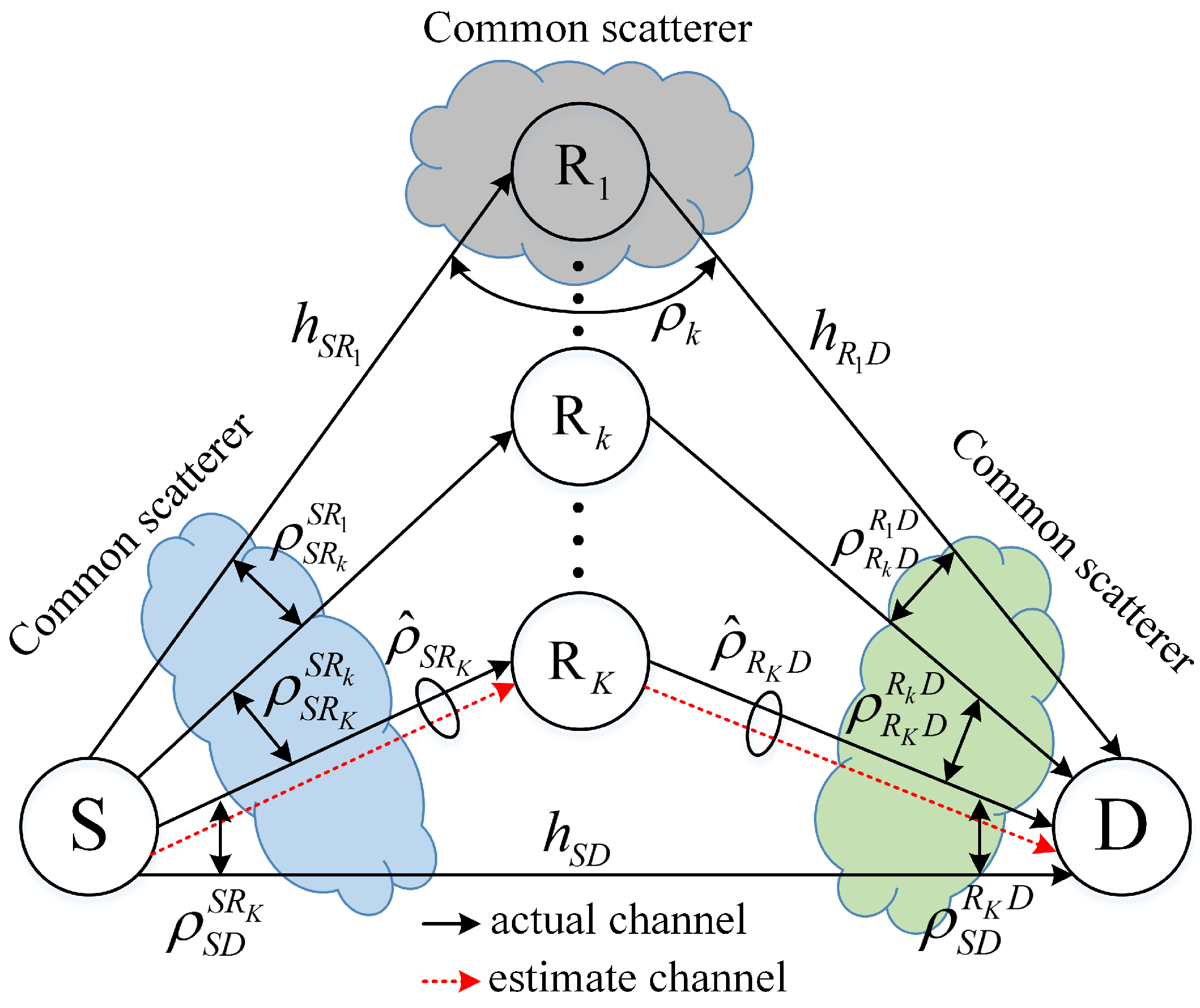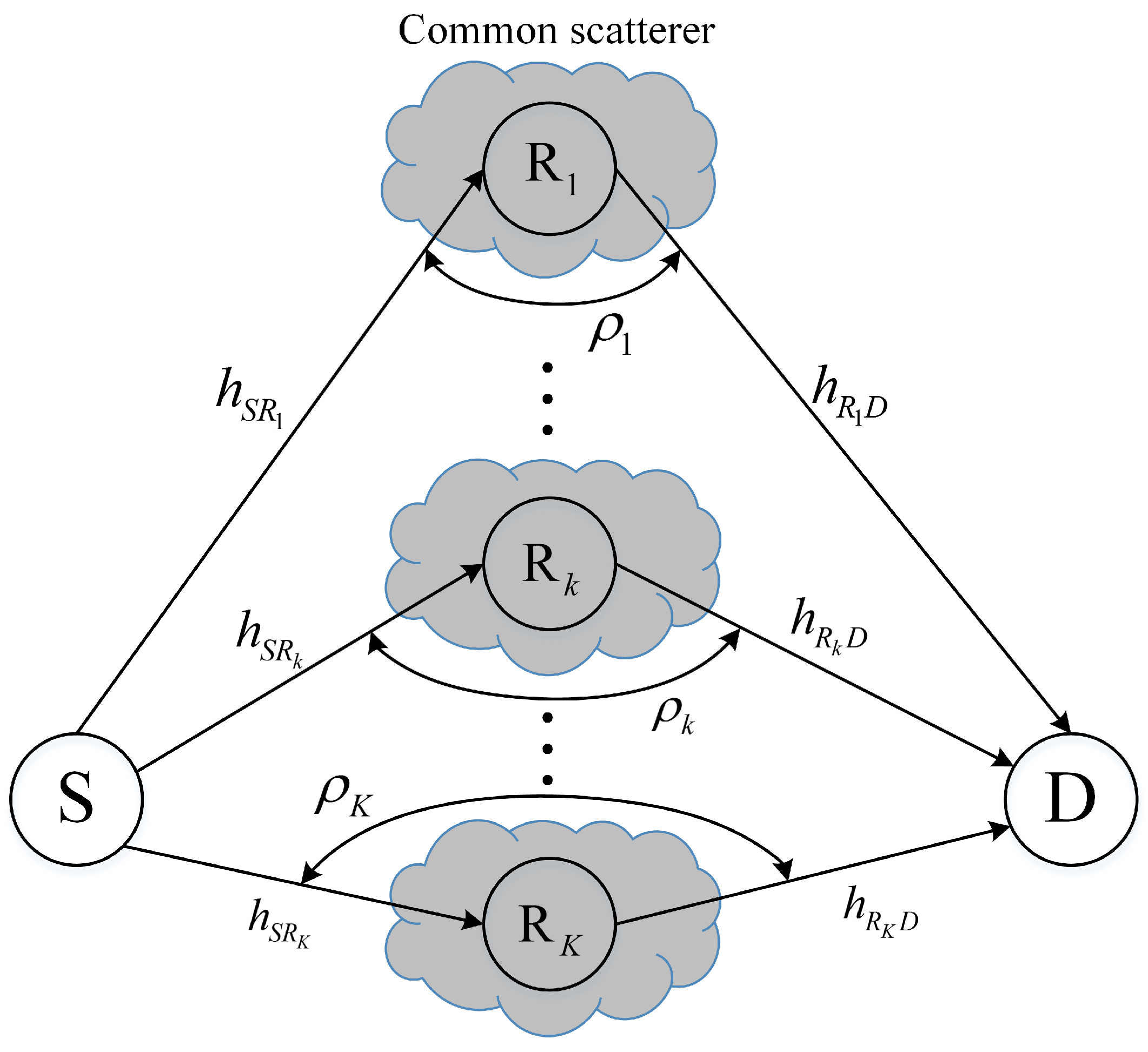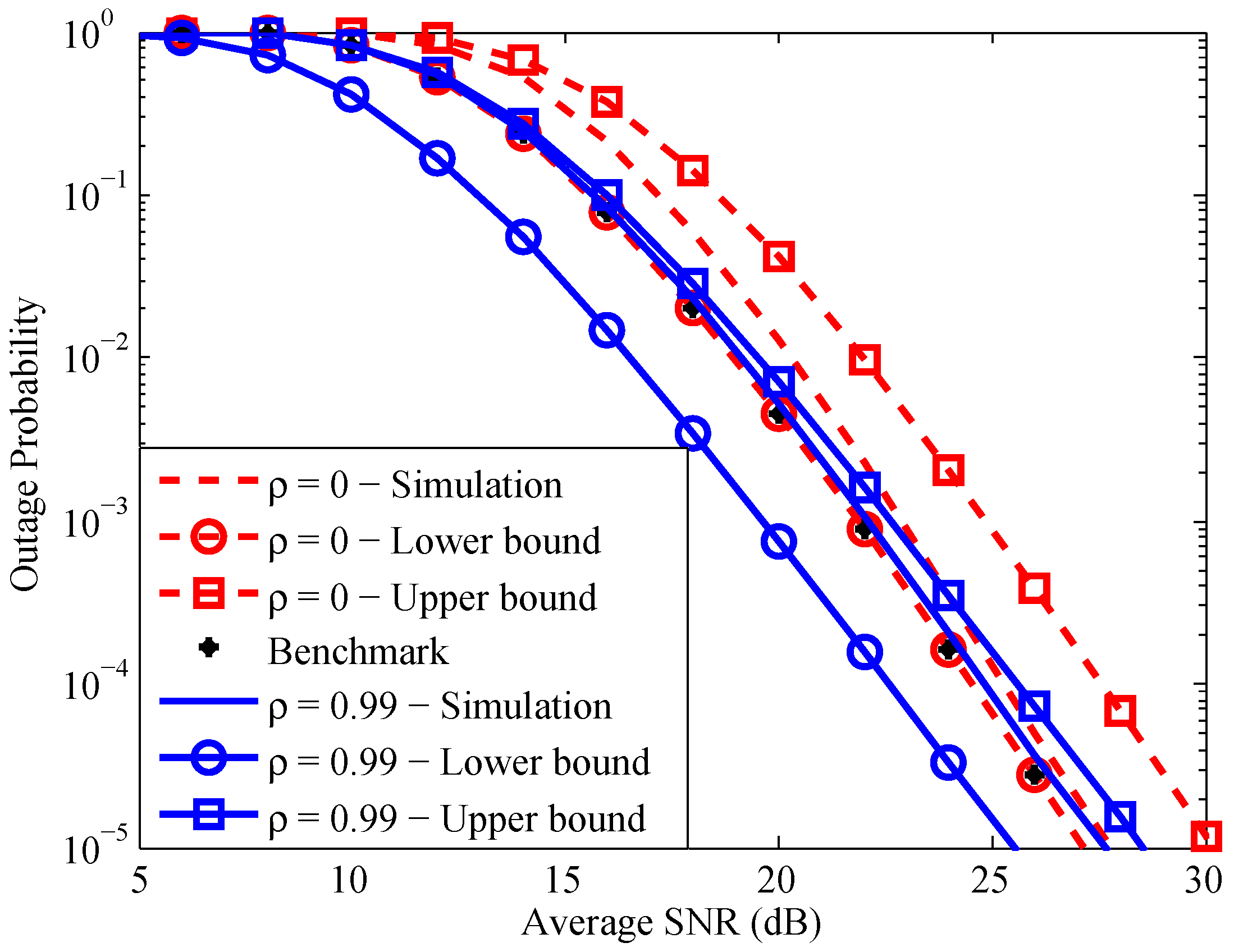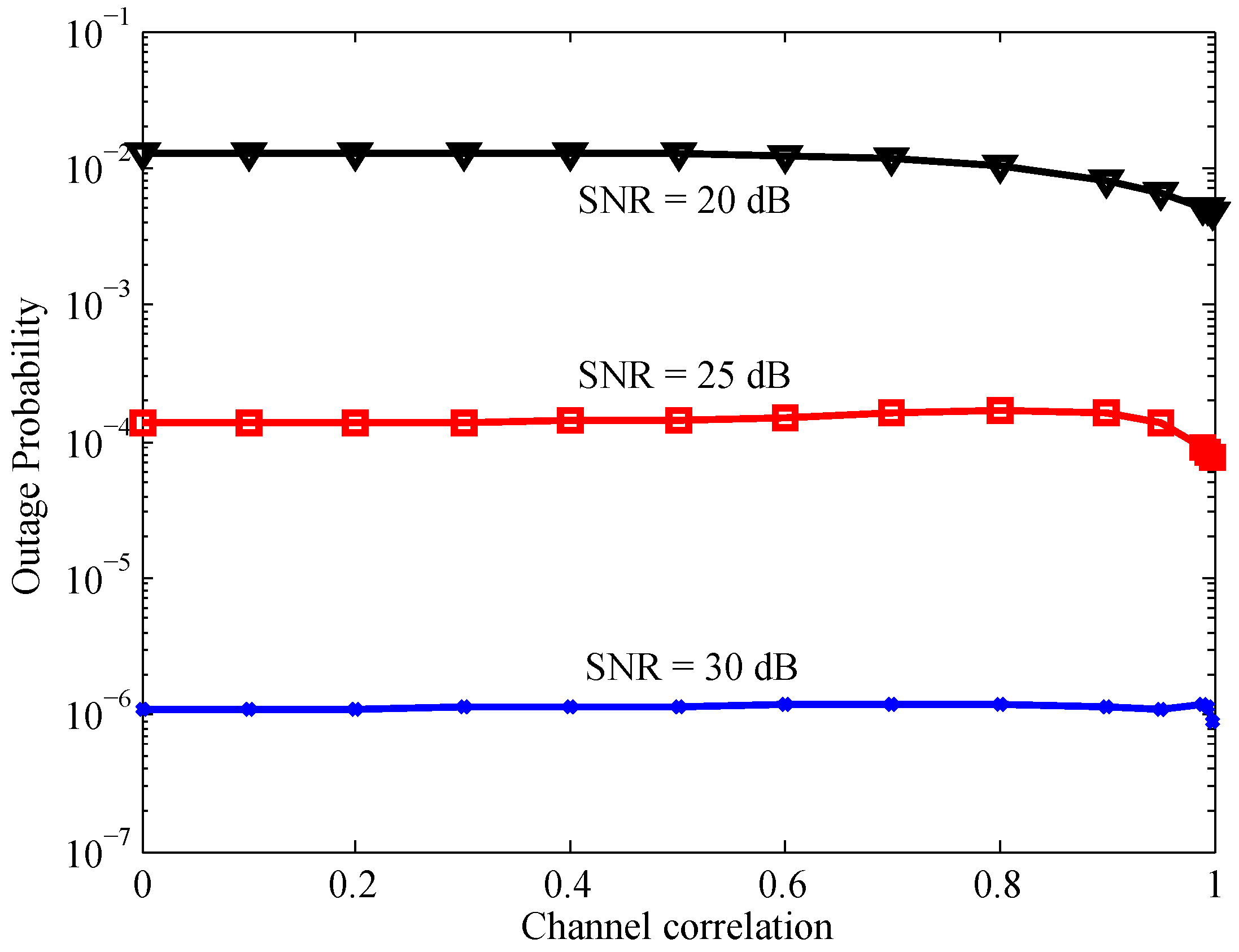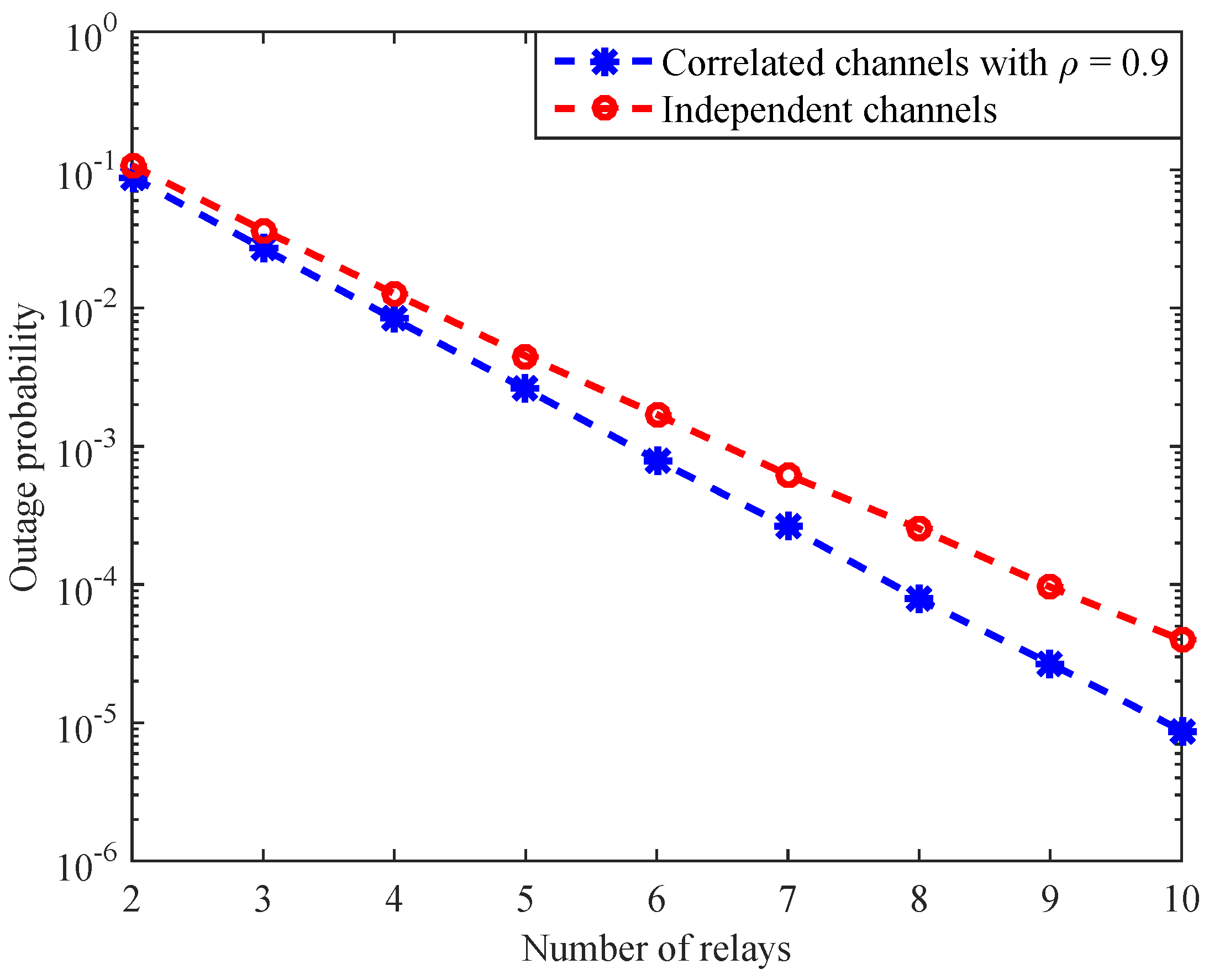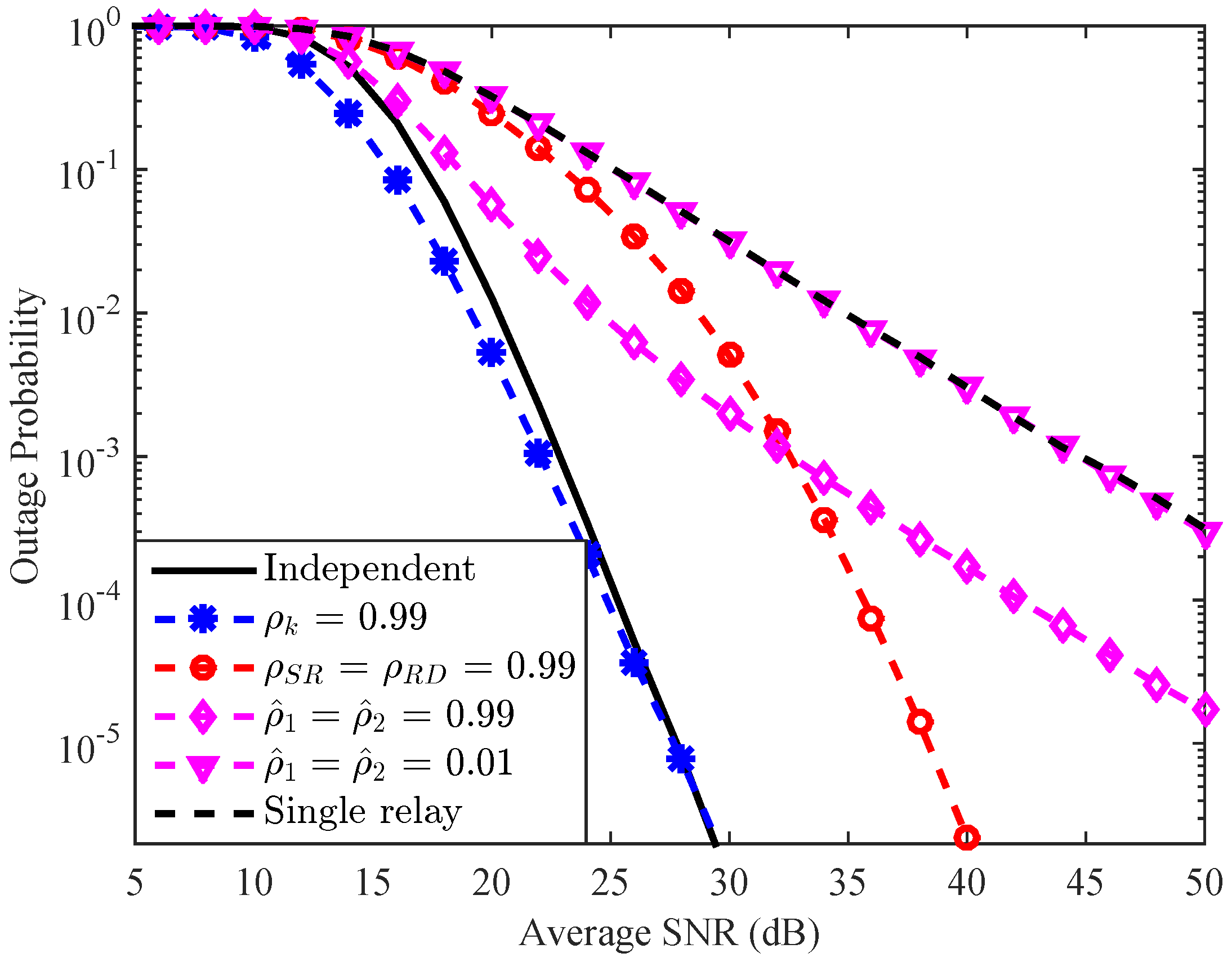1. Introduction
Cooperative communication is of considerable interest due to its ability to provide the benefits of spatial-diversity to single antenna systems. It is based on the shared nature of the wireless medium in which a number of distributed neighbors, called relays, can overhear a source’s transmission and forward a manipulated version of their received signal to an intended destination. Among various relaying protocols, the two most popular are amplify-and-forward (AnF) and decode-and-forward (DnF) [
1,
2]. In AnF systems, single or multiple relays simply amplify and then forward their received signals to the destination. On the other hand, in DnF systems, single or multiple relays decode, re-encode, and forward the outcome to the destination. In multi-relay cooperative systems, single relay selection (SRS) is of importance for practical implementation because it not only reduces the system complexity but also improves the system spectral efficiency while maintaining the system diversity order (DO) compared to schemes exploiting all available relays, i.e., orthogonal transmission, distributed space-time coding, and distributed beamforming schemes [
2]. SRS investigated in existing literature can be categorized as best relay selection (BRS) and partial relay selection (PRS) [
3,
4,
5,
6]. In BRS, a single relay is selected based on the instantaneous global (two hops) channel state information (CSI), while in PRS, only local (single hop) CSI is used to activate a relay. It is obvious that the BRS provides a better system performance than that of the PRS counterpart. However, the PRS scheme incurs much lower deployment complexity, and thus, is highly preferable for systems with complexity constraints.
Although SRS and related performance analysis have been extensively investigated, most of the existing works assume that wireless channels are statistically independent. However, in reality, wireless channels are likely to be correlated due to feedback delay, common scatterers, geometry of the channels, or characteristics of the channels [
7,
8,
9]. Particularly, in wireless cooperative sensor networks, nodes are commonly low-complexity and densely deployed. Therefore, feedback delay and common scatterers among nodes highly exist. An illustration of a general cooperative system, in which a source
S communicates with a destination
D via
K number of relays,
, in a correlated environment, is given in
Figure 1. In the given system, correlations may exist between the source-relay (first-hop) channels, between the relay-destination (second-hop) channels, between the actual and the corresponding estimate channels, between the source-
and
-destination channels, or between the source-destination and source-relay (relay-destination) channels. A detailed description of channel correlations is given in
Table 1.
Here in this work, we first review existing works on the effects of channel correlations on the performance of AnF systems. We then focus on our main contribution, which is to analyze the effect of the channel correlation between the two channels of each relay (source- and -destination channels) on the performance of a multiple AnF relay system with the BRS scheme. We quantify the system DO which is the foremost important performance measure that characterises the system behaviour in the signal-to-noise ratio (SNR) region. In addition, and importantly, from the system DO, we reveal novel insights on the impact of the considered correlation on the system performance. Particularly, we prove that the considered correlation does not affect the system DO. Moreover, we show that the considered correlation has a constructive effect on the system performance.
The remainder of this paper is organized as follows.
Section 2 introduces a general system model. A brief overview of existing works on channel correlations is given in
Section 3. In
Section 4, we present our investigation for the effect of the channel correlation between two channels of each relay on the system performance. Simulation results are provided in
Section 5, followed by our conclusion and discussion on future research directions in
Section 6.
2. General System Model
A general cooperative system in correlated environment is graphically depicted in
Figure 1. The system consists of a source
S, a destination
D, and
K number of relays, which are denoted as
. All the nodes have a single antenna that can be used for both transmission and reception. All the relays are in the half-duplex mode, and thus, cannot transmit and receive simultaneously; they also employ the variable-gain AnF relaying protocol.
The channel gain between node i and j is denoted as . The noise associated with each channel is modeled as a mutually independent additive white Gaussian noise (AWGN) with zero-mean and variance . We do not consider power allocation issues as they are outside the scope of this work. We assume that each transmitter (source or relay) transmits information with a fixed power P. We use the notation to refer to the instantaneous SNR of link . Additionally, we use and to denote the probability density function (PDF) and the cumulative density function (CDF) of a random variable X, respectively. Furthermore, the notation is the probability of an event Y.
Depending on the characteristic or geometry of the channels, channel correlations may exist. For instance, due to feedback or scheduling delays, the channel state of the selected relay at the selection decision instant can substantially differ from the actual channel during its data forwarding [
10,
11]. As a result, the correlation,
, exists between the actual channel (
) and the corresponding estimate (
). In other words,
and
are correlated random variables (RVs) with the following correlation matrix:
Alternatively, if there exist common scatterers near the source, the first-hop and the source-destination channels are likely to be correlated to each other. The reason is that nearby channels are often affected by the same scatterers (shadowers); therefore, channels’ losses are correlated [
12,
13,
14]. Consequently,
and
may be modelled as correlated RVs with the following correlation matrix:
Similarly,
and
may also be correlated RVs with a correlation matrix given by
when there are common scatterers in the vicinity of the destination. Moreover, in indoor systems or in systems in which the source-
and the
-destination channels are impinged by the same scatterers, the two channels of the relay
can also be correlated with the following correlation matrix [
8,
9,
13,
15]:
Because the relays operate in the half-duplex mode, each source-destination communication is divided into two consecutive phases. In the first phase, the source broadcasts its signal to the relays and the destination (if the direct link is available). In the second phase, the selected relay forwards an amplified version of its received signal to the destination. Suppose that
S communicates with
D through the relay
, then the total end-to-end SNR at
D is given by [
1]
where
and
In the BRS scheme, the relay that maximizes the bottleneck link is selected. Mathematically, the scheme is expressed as [
4]
On the other hand, in the PRS scheme, the relay with the strongest SNR over the source-relay (or relay-destination) link is activated, which is [
3]
or
In Equations (7)–(9),
b and
p are the indexes of the selected relays. It is also important to note that, sometimes, the best relay (according to either the BRS or the PRS schemes) may not be available to assist the source-destination transmission due to some scheduling schemes, loads balancing conditions, or insufficient transmit power [
16]. Consequently, we have to select the
best relay instead. This relay selection criterion is referred as the
-BRS and
-PRS in the sequel.
The previously presented relay selection schemes can be deployed following a centralized or a distributed approach. In a centralized approach, a central node (source, destination, or another dedicated node) maintains a table that contains all the relays with associated channel gains. Using the table, the best relay can be easily selected. In a distributed approach, each relay keeps a timer, whose initial value is inversely proportional to
for the BRS scheme, and
(or
) for the PRS scheme. Then, the selected relay will be the one that has the smallest initial value of the timer [
6].
5. Simulation Results
In this section, we provide numerical and simulation results to validate our analysis. The simulation setting follows the system model in
Section 4 with
bit/s/Hz,
,
,
(hence, the received SNR will be lumped into the channel variances), and
.
Figure 4 illustrates the relation between the system outage probability and the average received SNR. As a benchmark comparison, we use Equation (
6) of [
27] with some appropriate modifications to obtain a lower bound on the outage probability of the system under independent fading channels. We first can see that when
, the derived lower bound is exactly the same with the benchmark lower bound for the independent channels case. It validates our derived bounds on the system outage probability. Secondly, when
ρ is small (close to zero) the analytic lower bound is relatively tighter than the upper counterpart, while when
ρ is close to one, the analytic upper bound is relatively tighter than the lower one. This observation infers that the correlation between two channels of each relay has a significant impact on the relation given in Equation (
6). Moreover, it is worth noting that when the channel correlation coefficients increase, the system outage probability decreases in low and intermediate SNR range, while it stays the same in the high SNR region. This fact can be further validated through
Figure 5, in which we simulate the system outage probability versus the channel correlation coefficient for several average SNR values.
Figure 5 shows that when the channel correlations approach one, the system outage probability decreases. One reasonable explanation may be described as follows. The end-to-end SNR at the destination via the relay
is upper bounded by the minimum between the two single-hop SNRs, i.e.,
and
. Under the independent channel scenarios, when
is large,
can be small and mainly decides the system performance. In other words, when one of the single-hop SNRs is large, the system performance can be sometimes good and sometimes bad. However, when the channels are strongly correlated, if
is large,
will also be large with a high probability. As a result, the system performance will be good with a high probability. This observation implies that the considered correlation form has a constructive effect on the system performance. Note that a similar observation for a single DnF relay system under the same correlated environment has been recently presented in [
15,
28]. This is an important observation, which is in contrast to the existing results presented in [
17,
18,
19,
20,
21], where channel correlations therein have a destructive effect on the system performance. In addition, it is noticed that an increase of the average SNR enlarges the threshold where the system outage probability starts decreasing. Particularly, in a high SNR range, for most values of
ρ, the effect of channel correlation on the system performance is negligible.
To illustrate the effect of multiple relays on the system performance, we present
Figure 6 and
Figure 7. In
Figure 6, we simulate the system outage probability versus the number of relays at 20 dB average SNR for independent channels and correlated channels with
. The figure first shows that increasing the number of relays significantly improves the system performance, as expected. Moreover and importantly, it is observed that when the number of relays increases, the gap between the system performance under correlated channels and that under independent channels is enlarged. The reason is that the greater the number of relays, the greater the correlation coefficients we have. Since the correlations are beneficial for the system, the system performance is enhanced.
Figure 7 shows the upper and the lower bounds on the system outage probability and their asymptotic approximations given in Equations (25) and (26) for several values of
K. It is noteworthy that the curves generated by Equations (25) and (26) represent the system DO. We can see that the DO curves converge to their corresponding lower and upper bound curves in the high SNR region, which confirms that the considered system can achieve DO equal to the number of available relays. In addition, the figure indicates that, by implementing a greater number of relays, the system can obtain a much better outage performance. The reason is that with a greater number of relays, the system has more freedom to select the best helper for its communication.
In
Figure 8, we present a comparison among the effects of the correlations between a channel and its estimate
, correlations among the first-hop channels and correlations among the second-hop channels
, and the correlation between two channels of each relay
on the considered system performance. The ’independent curve’ also represents the case with perfect channel estimation. It is again confirmed that among the three correlation forms, only the correlation between the two channels of each relay has a positive impact on the system performance, even though the improvement of the system outage probability is diminished in the high SNR region. We observe that the dash curve with circle mark and the dash curve with asterisk mark are parallel with the solid curve in the high SNR region. It means that the last two aforementioned correlation forms do not affect the system achievable DO [
21]. On the other hand, it is shown that the two dash curves with diamond and triangle marks are parallel with the dash curve in the high SNR region. This observation infers that the first aforementioned correlation form significantly degrades the system DO, i.e., from four to one [
18,
19]. It is also worth mentioning that even with
(this corresponds to the case that the estimate channels are only very little outdated compared to the actual channels), the system performance as well as the system DO are seriously deteriorated. This observation implies that the full benefit of single relay selection scheme is difficult to achieve in practise since perfect channel estimation is not an easy task to be done.
6. Conclusions
In this work, we studied the impact of the channel correlations on the performance of AnF cooperative systems. We first briefly reviewed existing works on channel correlations. We then focused on analyzing the effect of the correlation between two channels of each relay on the performance of a multiple AnF relays system with the BRS scheme. Based on the lower and upper bound of the end-to-end received SNR at the destination, we derived the corresponding upper and lower bounds on the system outage probability. In addition, and importantly, we proved that the system can achieve a full DO equal to the number of relays. Moreover, we showed an interesting result that can be stated as “when the considered channel correlation coefficient increases, the system outage probability decreases”.
The scope of future research in this subject is quite broad. Hence, we now would like to discuss only a few interesting and challenging problems which are worth further consideration. Up to now, the equally correlated model, in which correlation coefficients are the same, has been largely investigated [
17,
18,
19,
20,
21]. Even though the equally correlated model could be considered as a worst/best-case benchmark and its related results help us to gain fundamental knowledge of the effect of the channel correlations on the performance of cooperative systems, it may fail to precisely predict the actual performance of cooperative systems in reality. To understand the true impact of the channel correlations, non-identical correlated models should be taken into account. Such a study in combination with existing results will create a more complete description of the effect of the channel correlations on the performance of relaying systems.
On the other hand, most existing works are focused on studying the performance/behaviour of cooperative systems under a single channel correlation form only, but have ignored the joint consideration of different forms of channel correlation. Although [
15,
29] investigate the joint effect of the correlations between source-destination and source-relay channels, between source-destination and relay-destination channels, and between source-relay and relay-destination channels on the performance of DnF systems, only a single relay configuration is considered. In addition, the presented symbol error probability given in [
15,
29] cannot be straightforwardly extended to multi-AnF-relay scenarios. Moreover, jointly consider inter-path correlation and correlation between a channel and its outdated estimate is also an interesting problem. Therefore, theoretical analyses and simulations are required to reveal novel insights on the joint effect of multiple channel correlation forms considering multiple AnF relays.
With recent advances in antenna design and signal processing, the full-duplex (FD) relaying mode has gained more and more attractiveness from the research community. The advantages of the FD relaying mode lies in the fact that it can address the inefficient use of resources, i.e., dedicated bandwidth or time-slot, of the half-duplex counterpart. Due to its advantages, applications based on FD relay systems will be widely spread in the near future. Hence, investigating the impact of the channel correlations on the performance of FD cooperative systems is necessary and important. In addition, taking the self-interference link between a relay’s input and output in FD cooperative systems into account will make the related problems much more challenging.
Finally, we note that although the broadcast nature of wireless medium greatly facilitates cooperative communication, it makes wireless data transmission vulnerable to eavesdropping attack. In addition, beside complex cryptography at the network layer, physical layer security (PLS) is emerging as a new paradigm to robust cooperative systems security level against eavesdroppers by exploiting characteristics of wireless channels and noise [
30,
31]. The advantage of PLS is that it can operate independent of higher layers, so that it can be used to augment existing security schemes. PLS quantifies a system secrecy by secrecy capacity, which basically is the maximum between ’zero’ and ’the difference between capacity obtained at a legitimate destination and capacity obtained at eavesdroppers’. Since the secrecy capacity is usually in complex form, investigating the effect of the channel correlations on the secrecy performance of cooperative systems is a research-worthy, yet challenging, problem.
